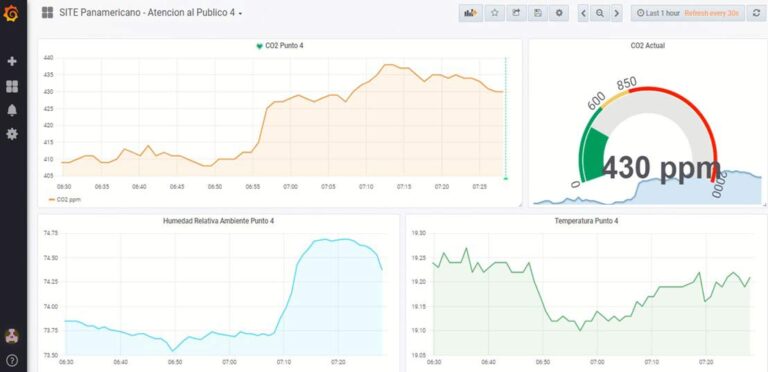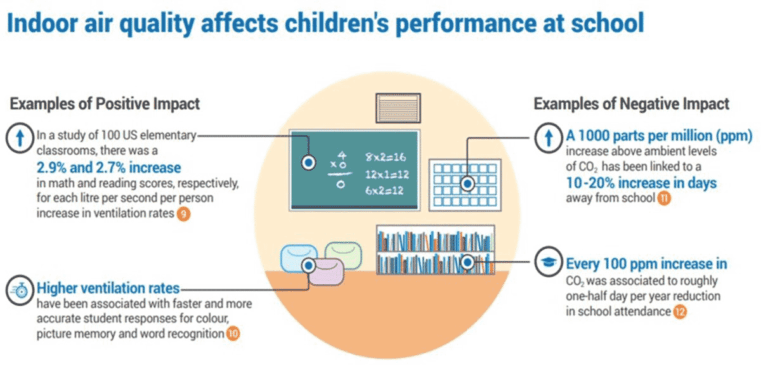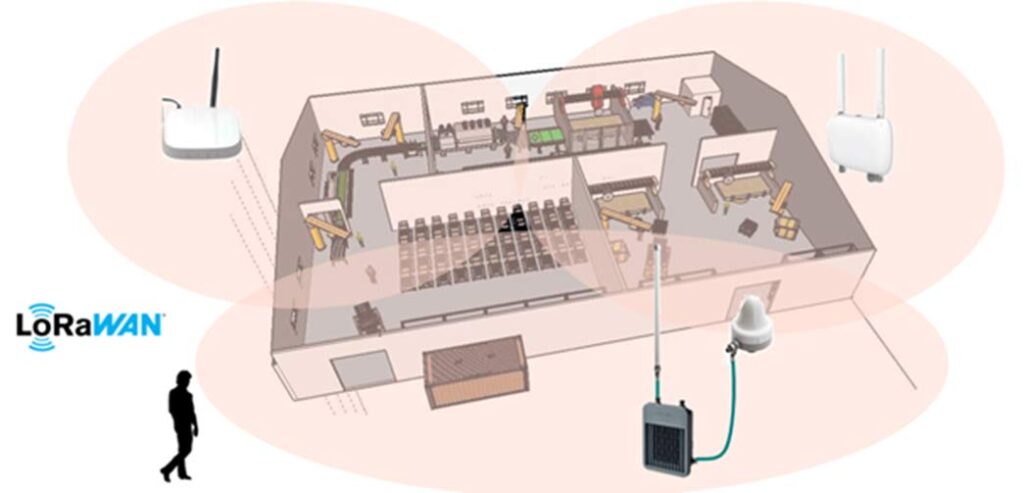
Blogpost, May 31st 2021
In the last few years, Indoor Air Quality (IAQ) has received increasing attention from environmental governance authorities and IAQ-related standards are getting stricter. People spend about 90% of their time in indoor environments, and IAQ has been proven to have a significant impact on health and quality of life in general. Poor indoor air quality is known to be harmful to vulnerable groups such as the elderly, children or those suffering chronic respiratory and/or cardiovascular diseases.
The COVID-19 pandemic has brought IAQ Monitoring to the front stage, as it plays a crucial role in minimizing viral transmission in schools, offices and restaurants. Besides enacting social distancing behavioral change, building owners and operators need to leverage a range of tools and strategies to optimize the operational performance of buildings in order to give their tenants confidence in returning to the workplace safely.
Enhancing indoor air quality (IAQ) could be as effective in reducing aerosol transmission of viruses as vaccinating 50-60% of the population according to scientific research. Monitoring carbon dioxide, volatile organic compounds (VOCs), particulate matter (PM), and also humidity and temperature, require installation of new sensors in facilities that usually do not have pre-existing wiring for IAQ. Such retrofit installations are greatly facilitated by wireless IoT networks and the fast-growing LoRaWAN standard has become the preferred infrastructure for IAQ monitoring.


CO2 concentration is a key indicator of air quality. As people spend more time in their homes, and even more during the pandemic crisis, indoor CO2 concentrations are often 2 to 5 times higher than typical outdoor concentrations. The optimization of air quality in rooms is essential for healthier and more productive indoor living and working conditions. Spaces with high CO2 percentages can cause headaches, drowsiness, and poor concentration, often resulting in a reduction of productivity. From 2.000 ppm onwards, humans can even loose cognitive abilities and can have significant health risks at higher levels.
On the past 2nd of May of 2019, a BE Royal Decree for the well-being at work was issued, stating that employers must take the necessary technical and organizational measures to ensure that the concentration of CO2 in workspaces is generally less than 900ppm. High amounts of CO2 also means that there is a high number of aerosols in the air, elevating infection risk for people in the room. This becomes especially relevant during the pandemic times we are living. When a person infected with Coronavirus coughs, speaks or sneezes, a spray formed of drops and aerosols is generated, penetrating the air in the room and spreading. Non ventilated indoor spaces have been proven to increase Covid-19 infected aerosol transmission.
Co2 measurement allows to know if the ventilation system is sufficient. The maximum CO2 recommended depends on the room, its occupation and the activity carried out inside it, but generally studies conclude that the risk of concentration rises when the Co2 in the open air is doubled, this being approximately 420 ppm.

McCool Controls deploys solutions against COVID-19, which allow to create occupancy heat maps, proximity detection and contact tracing, virus contamination mitigation, keeping within hand hygiene compliance or environmental and temperature monitoring.
Abeeway Smart Badge have been used in various Smart Health related use cases like to protect Zoeti’s workers in Japan from COVID-19. This was done by equipping each employee with a compact wearable badge, which enables easy monitoring of interactions within the common areas, also working alongside security badges for access control.
Indoor and outdoor tracing is also possible through these solutions, which also offer the possibility of patient wayfinding, medical devices tracking or patient ER/OR tracking, easily creating panic buttons so that patients can be localized in case of having an emergency, or pharma refrigerating tracking, to keep in the know of location, tracking and temperature control of medicines.
Actility, in joint work with Elsys.se and WMW, now offers a new Indoor Air Quality (IAQ) Monitoring Starter Kit to help enable safer and healthier indoor environments, helping protect employees, students and workers by meeting air quality regulation levels. The solution also seeks to protect against COVID-19 spread, by controlling and monitoring CO2 levels and people’s presence in closed areas.
This Indoor Air Quality Monitoring Solution, now available on ThingPark Market, Actility’s IoT solutions marketplace, allows to control and monitor CO2 concentration, temperature, humidity, light and people’s presence in real time. The IAQ Monitoring Starter Kit provides the required hardware, software and connectivity services to assess this integrated plug-and-play solution.
The solution has an extremely easy configuration. It can be used for any indoor space like, for example, classrooms, offices, meeting rooms, shops, industrial facilities, public buildings, and much more.
Axenova , an Actility Solution Partner in Argentina, created a solution for ventilation management to fight Covid-19 transmission. When ventilation isn’t frequent enough, aerosols are kept lingering in the air. The longer the area is kept without ventilation, the more compacted the air will get with aerosols.
The solution presented by Axenova collects the CO2 data from meters positioned in rooms, allowing to send the information to a metering center, an app with online information or an online platform with reportings, alarms and other settings. For this, the building needs to have a LoRaWAN gateway for devices to communicate. Actility offers the possibility to deploy a private LoRaWAN network using ThingPark Enterprise. The network server sends the data to the Axenova platform to later convert it into understandable insights shared on the app or platform.
This solution allows to gather real time information and set alarms offering the opportunity to act at the right time to avoid contagions, also giving access to historic data to refine protocols, reducing risk of contagion.

Veolia also offers air quality monitoring solutions. Their first offer around IAQ is Air Control, where Veolia assesses air quality, identifies potential sources of pollution, and recommends suitable solutions. Another one of their offers is Air Performance, for ventilation system evaluation and practices and installation improvement to guarantee results in air performance. Their third offer, called Air Human, makes information about air quality accessible and understandable, involves users into problem solving and takes the perception of people involved into account.
NanoSense, leading French company and winner of two AirLab challenges for the creation of IAQ monitors, is creating IAQ modular probes for indoors and outdoors. These monitors, which can also check humidity, ventilation conditions, RH, OTC, VOC, and other parameters, can connect to different protocols as well as LoRaWAN. These multi sensors monitor every 2 to 5 minutes, sending new information every 10 minutes, and can follow multi criteria remediation control algorithms, have a 10-year lifespan, a low life cycle cost and are easy to maintain.
Solutions like these have already been implemented in many fields which can easily benefit from air monitoring. These solutions are already running in public buildings, like government buildings, at the Environment Agency, for example, in airports like those belonging to the Aéroports de Paris (ADP), or in hospitals, like in St Luke’s Hospital in the United States. Also, in smart buildings like offices, co workings or in logistics, and even in services like shopping centers, hotels and restaurants, as an example we have the solutions implemented in Hard Rock restaurants, AMC Cinemas or Accor Hotels.
Schools have a big potential for IAQ and monitoring solutions should be installed in every classroom. Studies carried out in the United States have concluded that there is a real impact between children’s performance and attendance rate at schools and the quality of the air they breathe during class hours, and this issue gets even more relevant with COVID-19.
Veolia, NanoSense and Birdz joined forces to create a solution which would cater for schools in Raincy, France. The solution needed to solve the challenges of improving and guaranteeing air quality, while also installing the necessary equipment for it, and making the information accessible to people in charge of the school’s installations and parents.
The solution was carried out by placing NanoSense’s real-time monitoring sensors in each classroom, which were installed in only two weeks during school holidays. These sensors are equipped with LED indicators marking green, yellow, or red for the different levels of ppms, making it easy to visualize if the room needs to be ventilated. Veolia also installed IAQ probes in the ventilation systems to meet the highest CO2 control standards.
Once the sensors gather the data, Birdz, a company focused on environmental smart solutions for digital cities and a provider digital solution for Industrial and environmental IoT, performs the data collection and translates it into understandable insights, which can be consulted through apps, mail, sms real-time alerts, and automatic reporting and data visualizations to facilitate taking action.
Lastly, Veolia, through their Veolia Ofis IAQ experts, performed an audit evaluating all the results and raised awareness amongst the school occupants. This guaranteed indoor air quality for all pupils and parents, and children were informed and aware of the positive impacts of air quality, while getting to know about all the parameters which influence virus transmission risk.

The connectivity choice for this and most IAQ use cases is LoRaWAN for various reasons. Often a building just needs one gateway for a private network. If available, a public network can also be used. LoRaWAN specifically caters for IoT use cases that require battery-operated sensors and network coverage well beyond hundreds of meters.
LoRaWAN provides a low power and long-range connectivity, while most technologies like Bluetooth LE, Zigbee and Z-wave provide low power solutions, they aren’t designed to cover long-range distances, this feature is normally left to technologies like 2.5/3/4G, but on the other hand, these technologies haven’t been designed to cover the low power aspect needed for IoT solutions.
LoRaWAN is also an open standard technology, ensuring that there is no vendor lock-in, which can be key for long term assets, and an unlicensed band, providing flexible options to connect assets via public connectivity services, private networks, or both, leveraging LoRaWAN roaming capabilities. LoRaWAN also ensures that all devices connected to this technology in one same building or complex can connect to the same technology and coordinate. If the coverage isn’t enough for the area, antennas can be easily installed.


Learn more about the LoRaWAN technology by downloading the Actility “What is LoRaWAN” white paper